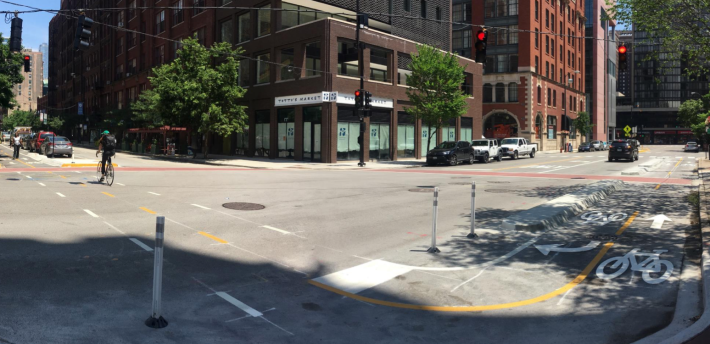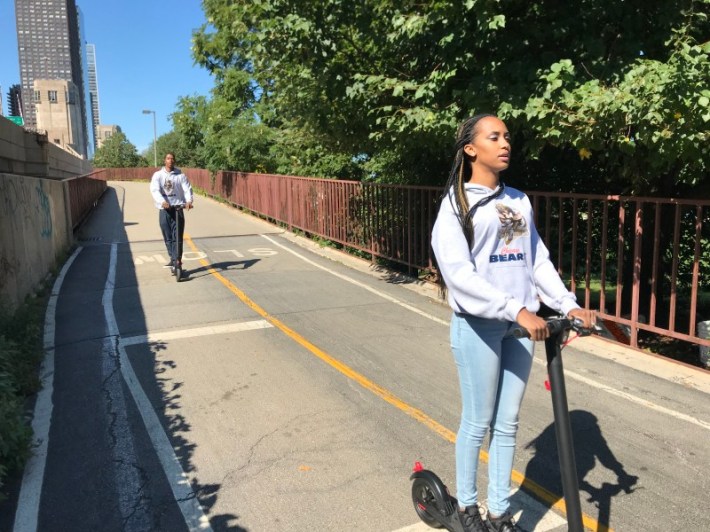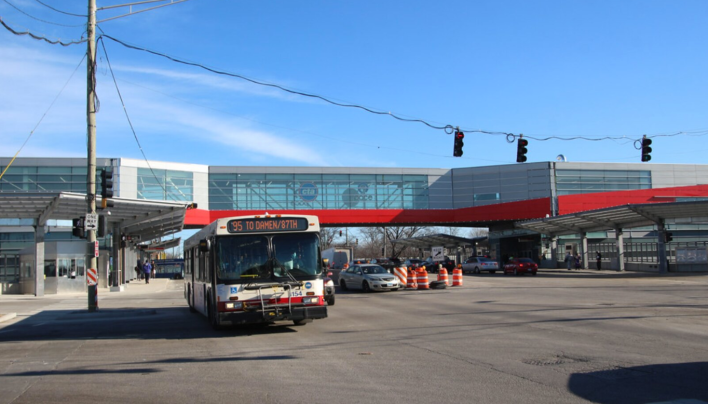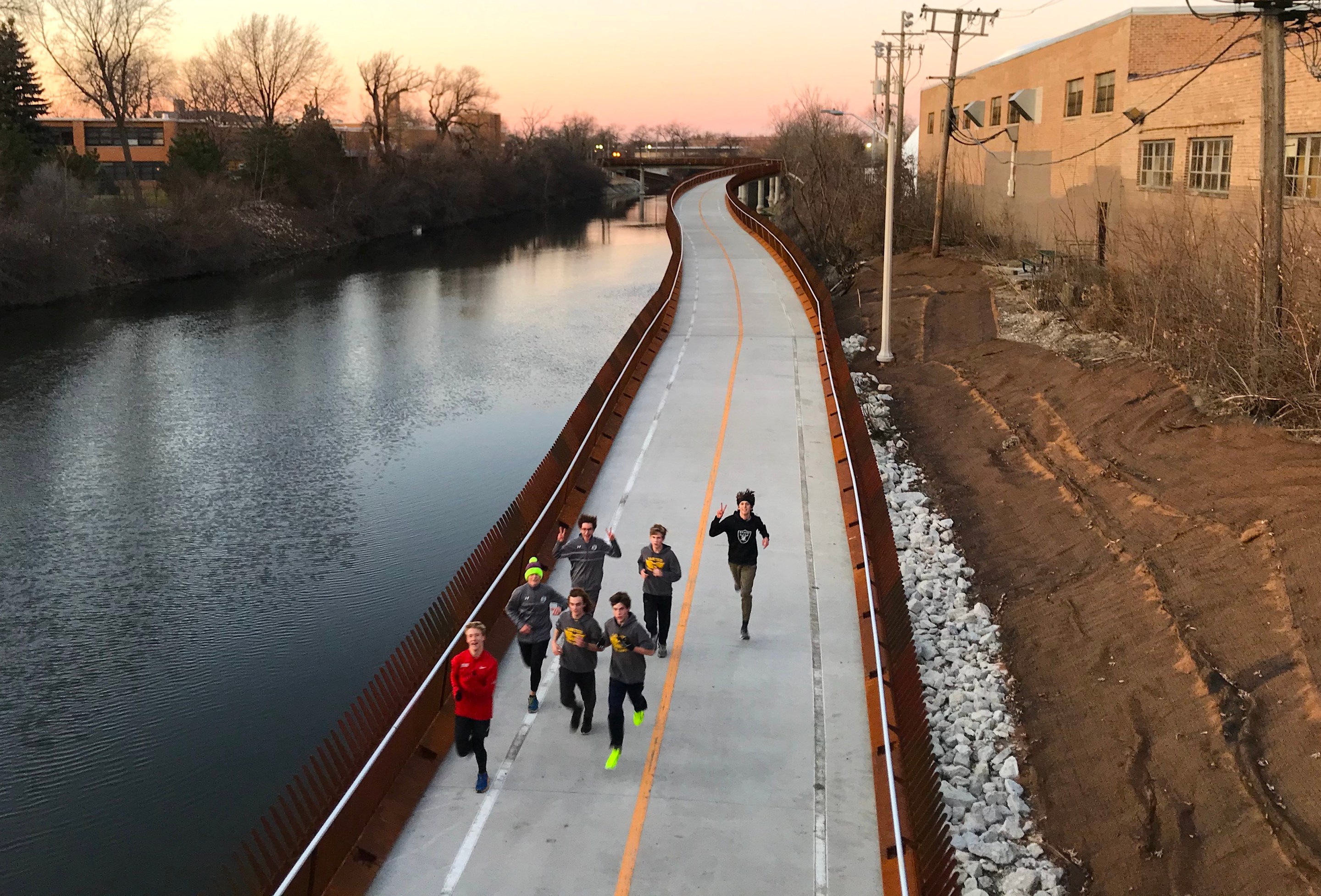
[This article previously ran in the Chicago Reader.]
It was only fitting that 2019, the year leading up to the new Roaring Twenties, should be a time of transitions, milestones, and new beginnings in the Chicago transportation scene.
The most obvious change was the May inauguration of Mayor Lori Lightfoot, the first Black LGBTQ woman to lead the city. While her predecessor Rahm Emanuel had a generally strong record on walking, biking, transit, and traffic safety, he was often accused of callousness when it came to marginalized communities. In contrast, Lightfoot promised to look at policy decisions through a racial and economic equity lens, and that was reflected in her transportation plan (which also seemed to be influenced by the Chicago Sustainable Transportation Platform released by Streetsblog's Steven Vance and Lynda Lopez a few months prior).
Some of the planks in Lightfoot's platform included addressing racially biased traffic enforcement and reforming the motorist ticketing system; reducing transit fares for low-income Chicagoans; and speeding up bus service with dedicated lanes, all-door boarding, and other time-saving features. Additional strategies included encouraging affordable transit-oriented development on the south and west sides; reforming the ride-hail system; and building 100 miles of new bikeways. She's generally been doing a good job of keeping her promise to promote mobility justice, with one glaring exception—more on that in a bit.
While 2019 saw many Chicago transportation triumphs, let's get the lowlights out of the way. Although the city's Vision Zero program, launched in 2017, has the goal of eliminating serious and fatal crashes, this has not been a good year for pedestrian deaths, with 36 cases as of early December, a higher-than-average number.
Bike fatalities are down, with only four cases to date, compared with the recent average of six, but the last two cases sparked outrage. On November 6, a turning truck driver failed to yield to school counselor Carla Aiello, 37, who was on her bike, crushing her under the wheels. To protest her death, dozens of people showed up to the Old Irving Park crash site, lining Milwaukee Avenue to form a "human protected bike lane" and holding a banner reading "Please don't kill us!"
Eleven days later an unlicensed driver killed cyclist Lee Luellen, 40, in Grand Crossing. Advocates were quick to point out that he was the second bike rider fatally struck in two years on that stretch of Stony Island Avenue, where Aldermen Leslie Hairston and Michelle Harris have blocked the installation of protected bike lanes.

On the bright side, this year the Chicago Department of Transportation completed a number of projects to improve safety and convenience for cyclists and pedestrians. These included adding concrete curb protection to bike lanes on 55th Street and in the South Loop; new bike lanes on the far south side, Little Village, and the near west side; and paint-and-post sidewalk extensions in Logan Square and Andersonville.
The most exciting new piece of bike/ped infrastructure is the Riverview Bridge, a serpentine three-block causeway connecting Clark and California parks near Lane Tech College Prep High School. The span, which opened last month without fanfare, is said to sound like a bass harmonica when the wind hits it just right. It's part of the 312 RiverRun trail network, which will eventually offer a car-free route for 1.5 miles between Belmont and Montrose avenues.
Another bike milestone was an agreement inked this spring between Chicago and Lyft, the Divvy concessionaire, to add 10,500 electric-assist bikes, expand the system citywide, and generate a guaranteed minimum of $77 million for the city over the remaining nine years of the bike-share contract, among other benefits. Lyft's archenemy Uber, which owns the JUMP bike-share system, fought the exclusive deal tooth and nail with a propaganda campaign. That included buying flattering "news" coverage in local media and recruiting dozens of clergy members, including civil rights icon Jesse Jackson, to back up Uber’s bogus claim that the arrangement would hurt poor people.

In other shared mobility device news, Chicago finally launched a dockless electric scooter pilot this summer, with a total of 2,500 scooters from ten different companies scattered across the west- and northwest-side service area. The test resulted in dozens of scooter related-emergency visits; residents griped about scooters illegally ridden and parked in the middle of sidewalks; and the gadgets even wound up in garbage cans, trees, and the Chicago River.
But the program was unquestionably popular, with about 800,000 trips taken over the four-month pilot, a better rides-to-vehicles ratio than Divvy. So assuming that the numbers aren't too horrific when the city releases the final injury stats, we should be seeing these gizmos across most of Chicago next year.

As for the CTA, the agency wrapped up a couple of high-profile station projects this year. The new $280 million 95th Street Red Line terminal debuted in January, garnering a generally positive response from south-siders for its futuristic, spaceship-like appearance and its public art installations by local artist Theaster Gates, including a sound studio with live performances by DJs, musicians, and poets.
The $17 million Belmont Blue Line station rehab in gentrifying Avondale was less warmly received. Its main feature is a giant, Jetsons-esque blue awning that would look more at home on top of a Superdawg stand. Neighbors also complained that, even after the reconstruction, the station still isn't wheelchair accessible. (The CTA said that would have added $55 million to $75 million to the price tag.)
The new Belmont Blue Line station canopy and @Superdawg. Who wore it better? pic.twitter.com/6nD3SGzS03
— John Greenfield (@greenfieldjohn) March 29, 2019
We can expect a lot more sustainable transportation infrastructure upgrades in the coming years thanks to the $45 billion capital bill passed in Springfield in April by rookie Democratic governor J.B. Pritzker, who hit the ground running after years of deadlock under Republican Bruce Rauner. The legislation included the unpopular but necessary move of raising the state gas tax, which had been stuck at a flat 19 cents a gallon for two decades, to 38 cents, and indexing it for inflation. The Active Transportation Alliance deserves a shout-out for successfully lobbying to include a $50 million annual earmark for bike/walk infrastructure, with a focus on underserved communities.
Another legislative victory for eco-friendly transportation was Lightfoot's late-November passage of a new ride-hail tax structure that lowers the price of the more sustainable shared UberPool and Lyft Line rides, while slapping a $3 surcharge on traffic-clogging solo downtown rush-hour trips. This strategy should reduce the Loop gridlock that slows down buses. And $2 million of the projected annual $40 million in additional revenue will be used for the city's Bus Priority Zone program, which includes bus lanes and other improvements on busy routes like Chicago Avenue, Western Avenue, and 79th Street. That should help stanch the CTA's ridership bleeding—the system has lost 48 million trips a year since ride-hail launched here five years ago.
Needless to say Uber wasn't pleased by the proposal, and they launched yet another misinformation campaign to paint the plan as unfair to poor people, even though most of the new revenue will come from downtown and the north side. They even enlisted 35 of the same ministers from their anti-Divvy offensive to promote that spurious talking point.
The one thing the mayor has been doing that is truly counterproductive to transportation equity is stonewalling a proposal by Cook County, Metra, and other local entities to lower fares and increase frequency on two south side commuter rail lines, which would improve transit access for low-income Chicagoans. Lightfoot claims she's worried about the impact on CTA revenue, but it's probably not a coincidence that she’s opposed to a plan whose most vocal proponent is her former political rival, Cook County president Toni Preckwinkle.
That's frustrating. But one thing that makes me hopeful for the next year of local transportation is Lightfoot's recent selection of Gia Biagi, who has led the urbanism and civic impact practice at Chicago’s renowned Studio Gang design firm, as the new commissioner of the Chicago Department of Transportation. Advocates applauded the pick: “We need designers and planners running transportation, not engineers and random bureaucrats,” said one. Biagi's firm, led by "starchitect" Jeanne Gang, is best known for downtown's unusual, watery-looking Aqua tower, and I'm optimistic that, by employing the same outside-the-box mentality as transportation chief, Biagi will make some positive waves.




